St Mary's Anglican Church
Caulfield
First organ: rem to Christ Church Anglican Church, St Arnaud.
Second organ: rem to Wesley College Chapel, Prahran.
Present organ: B 1933 & elec 1951 George Fincham & Sons. 3m, 13rks ext (54 spst), 6c, elpn.
Altns 1981- W.S. Glasson (new console piston and stop action completed 1991).
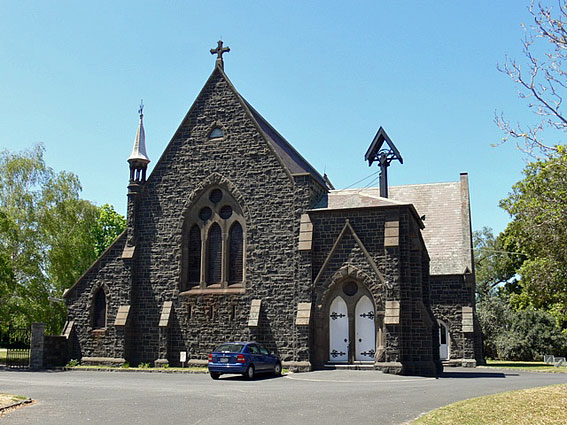
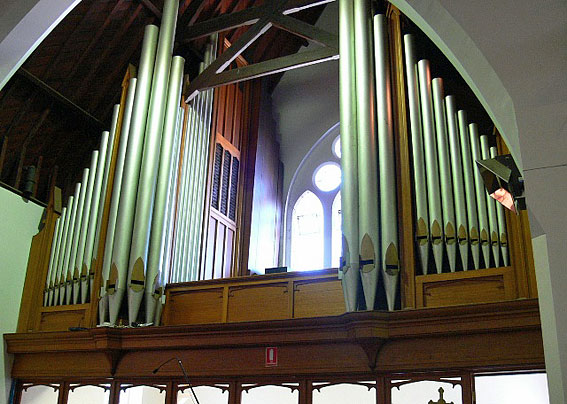
The first Anglican services in the area were held in 1858 and in 1871 the present church, built entirely in bluestone in a massive French Gothic style and designed by Reed & Barnes, was opened but without the intended tower and spire. The main façade is notable for its plate-traceried three-light window and tower base with Gothic doorway divided by a trumeau.
The building is attractively sited amongst large trees and gardens well away from the road. It consists of a three-bay nave, with aisle only on the north side, transepts, apsidal sanctuary and flanking vestries. The internal columns are of cast iron with elaborate capitals. It retains some of its cedar furnishings and includes many stained glass windows made locally and in Britain.
The first organ was supplied by Melbourne organbuilders Lee & Kaye and installed in 1867. It was rebuilt by George Fincham and moved to Christ Church, St Arnaud in 1877, where it still survives following a rebuilding in 1950 by W.L. Roberts and electrification by Hill, Norman & Beard in 1961.
The second organ built in 1875 by George Fincham was opened on 17 March 1875; this was placed in a chamber on the external wall of the north transept. This was a two manual instrument of 16 speaking stops and three couplers. The Mixture stop was replaced by a Clarinet 8ft in 1889. This instrument was used as the basis for the organ built by George Fincham & Sons Pty Ltd at Wesley College Chapel, Prahran in 1936. The unusual casework went to Wesley Church, Portland where it may still be seen.
In 1933 a new organ was built for St Mary’s Church by George Fincham & Sons Pty Ltd advised by the church organist Harold Rooksby. The firm had quoted £1925 to Canon Langley in December 1932 to build this instrument, less an allowance of £450 for the old organ, but was later to lose heavily on the contract (the firm wrote to Harold Rooksby on 8 August 1933 saying that “our loss will be considerable.”).
This was a three manual instrument consisting of 13 extended ranks operated by a very complex tubular pneumatic action. The mechanical complexity is evident in a photograph taken by Harold Rooksby at the time of installation with a mass of tubing runs and stacks of pneumatic switchgear. The organ was placed in a pre-existing gallery in the south transept, the Swell Organ in the left hand case and the Great and Choir Organs in the right hand case. The façade pipes consisted of the basses of the Pedal Open Diapason 16ft (the longest pipe was 17ft 2in long plus a foot of 2ft 1in and 10½in in diameter) and Great Open Diapason 8ft, and the Contra Gamba 16ft. The blowing plant was placed in a shed well away from the church walls and connected by underground terra cotta piping. The following ranks were ordered from Alfred Palmer & Sons, England: Great: Open Diapason, Gamba, Tromba; Swell: Open Diapason, Horn, Oboe; Choir: Clarinet. The remainder of the pipework was made by the Fincham firm.
The tubular pneumatic action of the instrument proved troublesome and at the end of 1935 Fincham & Sons lost the maintenance contract. However, in 1951 the instrument was rebuilt by George Fincham & Sons Pty Ltd with electro-pneumatic action but retaining the whole of the 1934 tonal scheme, console, windchests and pipework. More recently the wooden 1933 drawstops (which appear to be of 19th century origin, possibly those from the Australian Church, Melbourne) and piston action were replaced by Bill Glasson, the church organist, with new all-electric units and completed in 1991. However, with further unreliability, the original console is now connected to a Musicom electronic instrument, but all the original pipework, chests and case remain in situ unaltered.
The organ has been classified by the National Trust of Australia (Victoria) as a significant instrument that was unusual and even experimental at the time.
GREAT |
16 16 8 8 8 4 4 4 2-2/3 2 16 8 4 16 8 8 8 8 4 4 4 8 2 1-3/5 1-1/3 16 8 8 4 16 16 8 8 4 8 4 8 4 16 8 32 16 16 16 16 16 8 8 8 8 4 16 8 8 |
(enclosed except rank C) A B C A B C A B A A D TC D D # E F E F G TC F E F G E F F H I H I # A B A B A D D J J K K # L L (wood: unenclosed) C A N E L C A B B H K D # # # |
# operated by rocking tablets
Compass: 61/32
Detached drawstop console
6 divided key touches to Great and Pedal
6 divided key touches to Swell and Pedal
6 divided key touches to Choir and Pedal
1 key touch full Swell reeds
1 key touch full Swell flues
1 key touch full organ
1 key touch soft organ
6 toe pistons to Pedal Organ
2 rocking tablets coupling Great and/or Swell combinations to Pedal Organ toe pistons
6 toe pistons controlled by 3 rocking tablets giving Swell, Great and/or Choir combinations
1 reversible toe piston Swell to Great
1 reversible toe piston Great to Pedal
1 toe piston full organ
1 toe piston soft organ
Wind pressure: 6 in
Action pressure: originally 12 in
Balanced electro-pneumatic swell pedals
 |
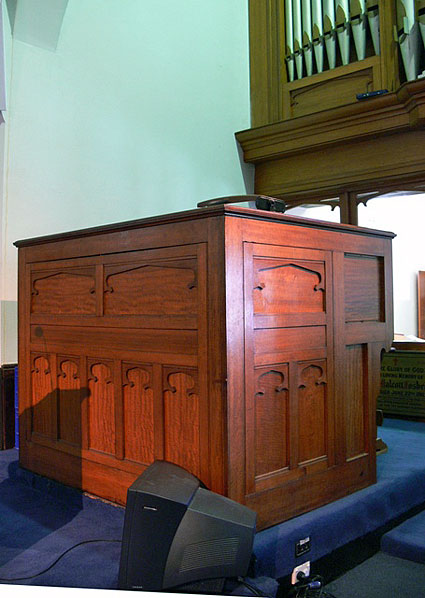 |
|
 |
 |
|
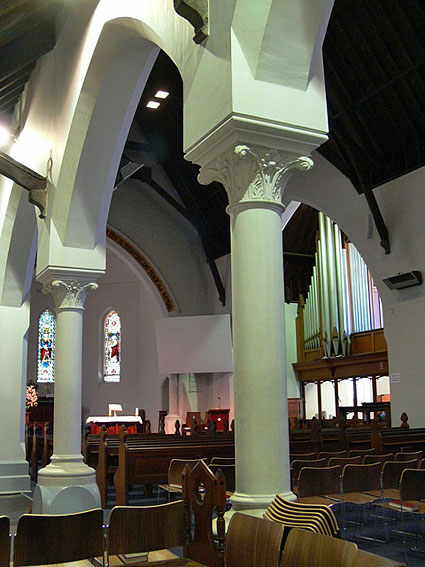
|
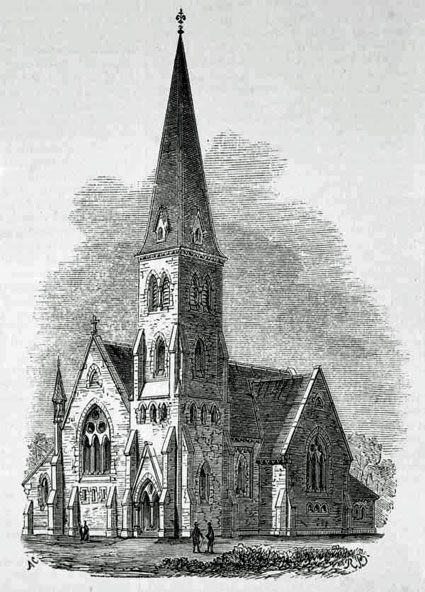 |
|

|
 |
|
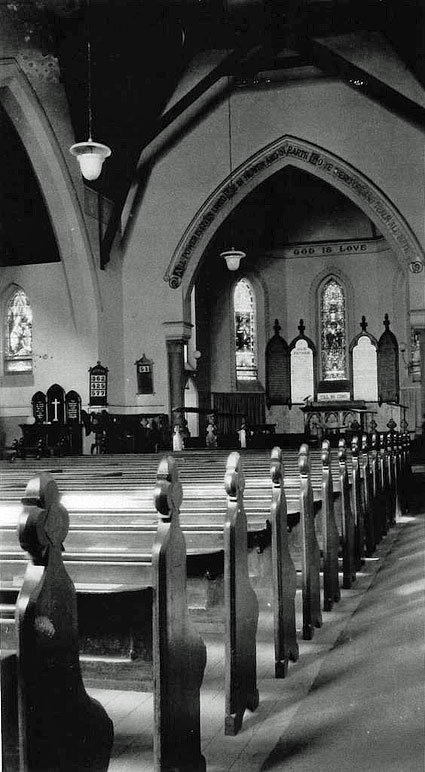
|
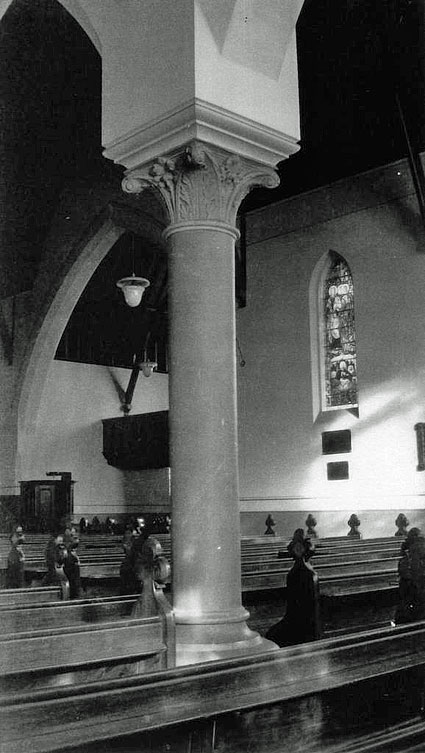 |
|
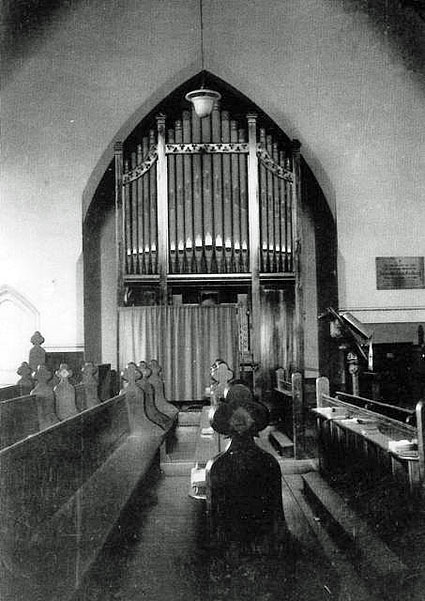
|
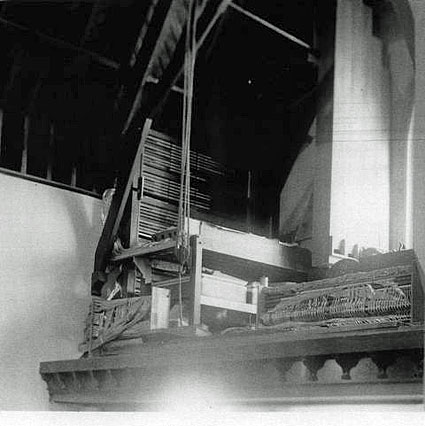 |
|

|
||
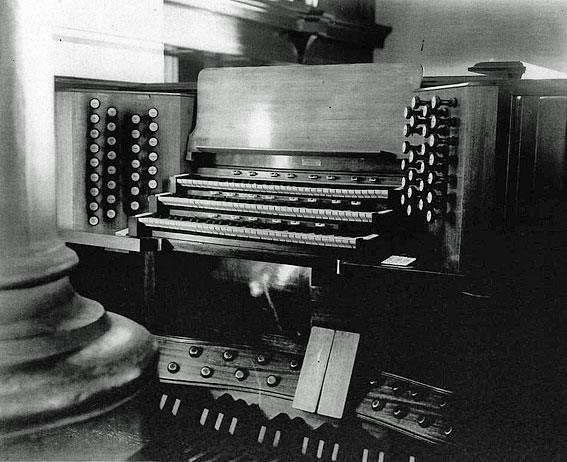
|
||

|
||
The black & white photographs were taken by Harold Rooksby around 1933
Colour photos: JRM (Oct. 2008)
George Fincham & Sons Pty Ltd letter books (State Library of Victoria)
E.N. Matthews, Colonial Organs and Organbuilders (Carlton: Melbourne University Press, 1969), p.126
Specification from Society of Organists (Victoria) first annual report (1938)
Personal communications Harold Rooksby and Bill Glasson
John Maidment
23 October 2008